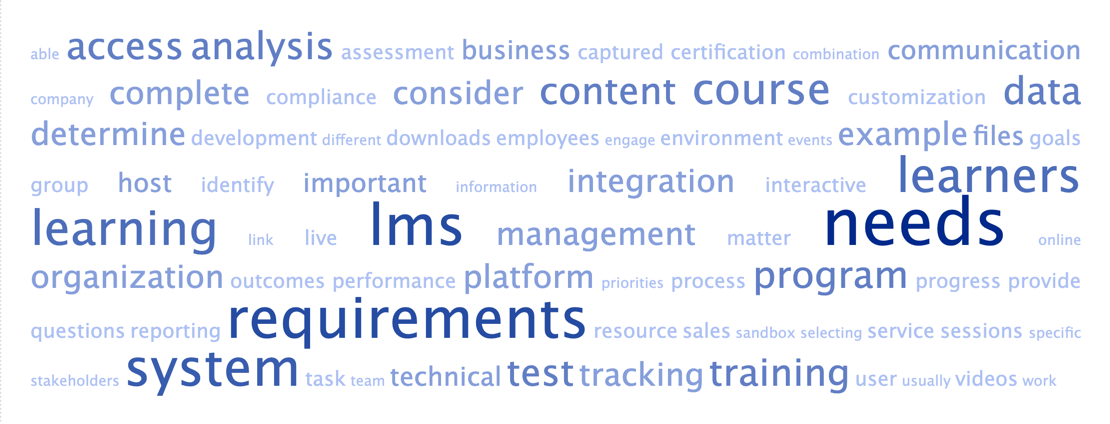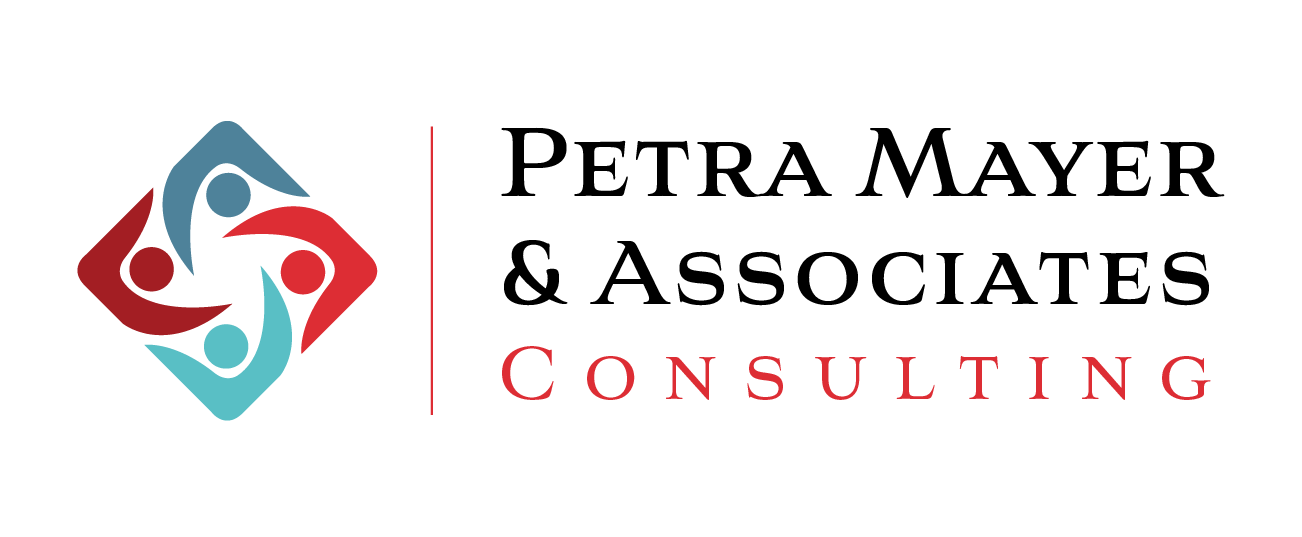When consulting with a company or organization that decides to roll out a new Learning Management System (LMS), I typically encounter many questions. An LMS Needs Assessment is designed to answer the following questions (and many more).
- Which LMS is right for us?
- How will we maintain the LMS, so it serves our needs today and 5-10 years into the future?
- What resources do we need to implement the LMS?
- Which department will be responsible for the LMS strategy and maintenance?
- How will the LMS support our business objectives and how will we measure the ROI?
And many more…
The complexity of this project can become overwhelming at times.

Purpose of an LMS Needs Assessment
A Needs Analysis turns the conversation on its head. Rather than having the chosen LMS determine the outcomes to these questions, I recommend to take the strategic approach. This will determine what is needed and it will identify the LMS that best suits those needs.
In this article I will review what needs to be considered for a thorough Needs Analysis with the effect that as an organization you are able to make the most educated choice when selecting your new Learning Platform. The Needs Assessment is an integral part of your LMS Feasibility Study, which I cover in another article.
1. Reporting Needs
Platform Types
You may be surprised why I am starting your LMS Needs Assessment with reporting needs. And here is why: The type of tracking you need determines if you even need an LMS.
Imagine going through a lengthy needs assessment, only to find out at the very end that an LMS is not what you need and that there are low cost alternatives that will do the job for you. Hence start with the Reporting Needs to eliminate an LMS if you don’t need it early on.
If, for example, you are a business owner who wants to add training programs to your service offering and you don’t need to track their progress or performance, then you likely don’t need a full LMS. You may be a creator of an online course built from a selection of videos and downloads, possibly combined with live interaction and a forum such as a Facebook group. In those instances, you do not need to create technical eLearning files that provide you with detailed tracking.
You can host your assets such as videos, downloads, quizzes in an online course platform that is cheaper to maintain and easier to manage.
You can still issue a certificate of completion. The source for that certificate is based on how the client tracks their own progress and not necessarily a knowledge test.
However, if you offer compliance training or a certification program and you need to ensure that the participant has not only viewed the program but also successfully completed a compliance test, an LMS is mandatory for you to sufficiently track the performance.
Test Data
What type of test data might you be interested in?
- Completion Rate
- Time it took to complete the course
- Number of attempts to complete the test successfully
- Test rate
This data will provide you with the results of your learners’ test outcomes which is the goal in many compliance programs and a pre-requisite for a certification program. Keep in mind that at the same time you will not know if this actually changed your learner’s behaviour at work but that is worth another article at another time.
External Data
Depending on the group of learners you have, you may want to link this data with other data from different sources.
One of my clients is a typical example for this. Their learners are their distribution partners. For this client the link of the learner assessments to their sales data is a mandatory component. Hence, you might require an integration with your sales systems, such as Salesforce.
On the other hand, I am presently working with an organization where their learners are employees, and they want to link their training records and assessment outcome data with their performance review and their overall corporate development path. In this case you may want to integrate your LMS with your Human Resources Information System (HRIS).
Stakeholder Involvement
Each situation is different, and it is therefore very important to bring the right stakeholders together to provide insights into the tracking and reporting requirements as part of the LMS Needs Assessment early on. This will determine the type of LMS you need and what system integrations are required. As an added bonus this exercise will also determine the learning design in great part.
2. Business Goals
Your overall business goals are the foundation of the requirements of your learning and development initiatives. Start by identifying your business goals and breaking them down into SMART goals that are specific to your learning platform needs.
Business goals may be structured around:
- Profit (revenue, margin)
- Employee retention
- Product and service quality
- Productivity
LMS goals may be:
- Variation in training delivery
- Mobile accessibility
- ROI
- Certification
- Reporting
- Learner interaction
- Completed learning paths
Clarity of your specific goals can drive requirements that need to be captured for the Needs Analysis.
Training is often considered as a response to a performance gap. Once the performance gap is identified and a training initiative has been designed, it will need to be hosted on the Learning Platform.
The LMS of choice needs to support the business requirements with regards to the investment of the platform implementation and maintenance. After collecting this information in the LMS Needs Analysis, you will analyze the fit to your business requirements in your Feasibility Study for your LMS project.
3. Learner Needs
Usability Needs
Your learners need high usability.
Regardless if your learners are internal or external to your organization, it is important that they can easily access and navigate the learning content. But what does “easy” really mean. Depending you your circumstances you may need to define the specifics for how your learners:

- Have access the content
- Navigate through the content
- Find relevant information
- Engage with the content
- Get questions answered
- Accomplish a sense of gratification upon completion
- Have some fun while learning
A user-friendly interface that guides your learner through the program is a must. Understand how your learners will access the learning material. Will they be on a desktop with broadband internet access or will they access the material remotely from their mobile phone, tablet or laptop with potentially intermitted internet access?
Specific User Experience Needs
In addition, you might have very specific needs for your user experience.
Your learning intervention may be a combination of traditional training program, on-the-job micro-earning and a reference library. Your training programs may be evergreen, on-demand dripped content or scheduled. And you might include live interactions either as Virtual Instructor Led Training (VILT), in-person training or as regular Q&A calls or walk-through sessions. You might even include one-to-one coaching sessions or demonstrations.
Knowing your needs and documenting them in your LMS Needs Assessment of how you want to deliver your existing and future training content is important when selecting an LMS that will accommodate those requirements.
Registration Process
How your learner will receive access to the content also has an impact on your LMS. Consider how a learner will be registered for the course. Are they going through an online registration process and their purchase needs to trigger access to the course? Or are you enrolling them in a bulk upload or individually. Maybe you need multiple ways to register your students and your LMS needs to accommodate that.
4. Content Needs
Content Types
Typically, training content can be any combination of:
- Videos
- Downloadable documents
- Assessments
- Forms
- Quizzes and tests
- Access to live sessions
- Interactive learning content (e.g. SCORM or xAPI files)
These files will need to be hosted either in the LMS environment or on another server that is accessible through the LMS.
Usually Learning Management Systems have the capability for you to upload text, images and downloadable documents. Some will allow you to upload your videos, while others require those to be embedded from a video hosting platform such as Vimeo, YouTube or Wistia.
Gather the needs for the different file types and list them in your LMS Needs Analysis.
SCORM Enabled Files
Not all systems have the capability to host SCORM enabled files. Those are the actual eLearning files that can be interactive and that allow for complete progress tracking. You see why I covered the reporting needs first. If you don’t need to track, you won’t need the SCORM files and you have greater range of more economical choices of where to host your courses.
Other Company-Specific Needs
Does your organization have other needs that are relevant that may be very specific for you? For example, you may require a Learning Management System that can handle multiple languages or that allows you to customize all labels and the way your courses are structured. These needs may disqualify some LMS options early on. Ensure you capture all needs, even those that you consider a basic requirement.
5. Communication Needs
Organization-Learner Communication
Another factor to consider is communication requirements. Do you want notifications to be sent directly from your LMS system? This capability can be a time saver, particularly if messages are generated automatically to provide information to students about events or course material that they subscribed for.
Integrated live events such as webinars or even in-person events may also require notifications and reminders.
Often you will want to make adjustments to the default messages and your needs in this area should also be captured in your Needs Analysis.
Learner-Learner Communication
Communication between you, the organization that offers the learning, and your learners are one thing. Another is communication between your learners.
Learners can advance through the joint experience and having the ability to communicate with other participants in the program can give your learners more incentive to stay engaged. This may require a forum, or discussion group. Alternatively, you may want to provide this in an external resource, such as a Social Media Group environment or even a mobile app.
Team Communication
If you are working in a larger team that needs to have access to the learning programs particularly during development, you may also want to have the ability of authors, editors and administrators to communicate about the draft versions of the course. This typically happens in a sandbox environment where the Subject Matter Experts can view and comment on the progress of the course development.
This brings me to the technical requirements for your LMS.
6. Technical Requirements
Test Environment
A sandbox might be the first and very important requirement from a technical perspective. Building a course should not happen in a live environment and instead be partitioned so that only course creators and stakeholders have access. Yet, the sandbox should be a true reflection of the final LMS experience.
Other technical requirements that often result in increased implementation costs are:
- Single-Sign-On (SSO)
- User management
- System integration
- Data security
System Integrations
Single-Sign-On is desirable if the user is accessing multiple systems. For example, if your employees are accessing the Intranet, the Training Platform, your company’s network and other systems, they ideally only need to sign into one system and have access to all.
This requires your LMS allowing a Single-Sign-On API development.
Already mentioned above, your learner’s activities in the learning environment may need to be captured in another system like your HR system and an integration will be necessary.
Some HR systems come with an integrated LMS which can make this easy as long as the LMS components satisfy all your other needs.
If your learners are external, for example your distribution partners, you may want to see their learning activities in your sales system such as Salesforce. This will often require an API customization. An alternative may be a regular and scheduled data export and import into your sales system. If a data export/import is the way to go for you, be sure to understand the data requirements to make this a smooth transition.
Other systems that may require integration are:
- Payment system
- Website and intranet
- Cloud services
- Webinar platform
- Calendar tools
- Customer service platform
Usually, the IT department will be involved in determining the full range of technical requirements as part of the LMS Needs Assessment. I often find that this is where “the devil is in the detail” and it takes a team effort to be really clear on the system requirements.
7. Specialty Requirements
There are many more potential needs that your company may have and that need to be considered in your Needs Analysis.
For example, you may want to consider the following:
- e-Commerce (options to sell courses)
- Customization (perhaps you want to white-label your courses)
- Leaderboards and gamification (to generate a fun competition between learners for increased engagement)
- Consideration to include Artificial Intelligence
Knowing the speciality needs upfront helps you to identify the Learning Management Systems that best suit your needs.
8. Prioritization Needs
Prioritization Process
By now you see that there are many needs to be considered when you choose a Learning Management System. As a matter of fact, it is a project in itself to determine the needs for your organization.
This usually happens in one or more brainstorming sessions and detailed interviews with stakeholders and Subject Matter Experts (SME).
Once the requirements have been captured in your LMS Needs Assessment, they need to be prioritized. It is unlikely you will find an LMS that is a perfect fit for all your requirements. You may need to compromise.
Having clear priorities of the individual needs will help to come to a conclusion. In your LMS Needs Analysis you might put a weight on each of the requirements in a simple three-tier approach:
- Must have
- Highly desirable
- Desirable
Flexibility
What I have seen in my work is that regardless how much effort you put into your requirements analysis, there are always some requirements that will be recognized later. As a matter of fact, when you review the first systems against your requirements you will see different executions, for example in the user interface. You will at that time be able to define your needs in a more granular way. I recommend building in some flexibility in your analysis process.
It is important to understand which needs are firm and cannot be adjusted while being flexible to learn throughout the process and use that as an opportunity to become even more refined in your Needs Analysis.
A consultant can be a great resource to ask the right questions as they come with a fresh view to the organization. They are also an unbiased resource when developing your LMS Needs Assessment with an objective to meet your requirements to the fullest extent possible.
Next steps
Now that you have compiled undoubtably a long list of requirements, your might wonder what to do next.
I recommend that you formulate clear requirements statements. These will be Functional Requirements defining what the system should do, and Non-Functional Requirements, defining how the system will do it.
The functional requirement is describing the behaviour of the system as it relates to the system’s functionality. The non-functional requirement elaborates a performance characteristic of the system.
Enter these requirements in a way that is clearly measurable into a spreadsheet under the various headers I provided in this article or in another categorization that works for your organization and use this in your process to obtain information from suppliers.
You can see a simplified version of this in my article “3 Priority Questions for your LMS Feasibility Study”.
To sum it up…
Identifying the needs for your LMS is a substantial task that should not be underestimated. It often is assigned to a team member who will try and accomplish the task as a side-of-the-desk project and that is a recipe for disaster.
Whoever will do this task, if an internal staff member or a team of cross-functional employees or if you hire an outside consultant to lead this process, it needs to be done with the proper care.
To learn more about what it may take to create a Needs Analysis for your Learning Management System contact me for a no-obligation consultation.
